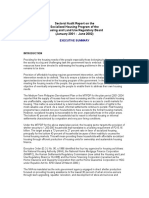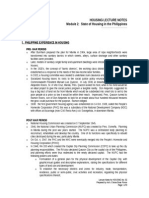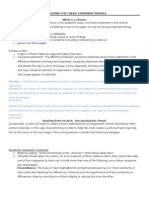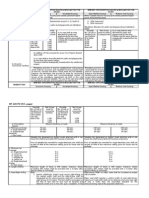100%(2)100% found this document useful (2 votes)
506 viewsPhilippine Human Settlements Development and Planning Page 1
Philippine Human Settlements Development and Planning Page 1
Uploaded by
AlecsisRoeEstañolFrascoSpanish colonial rule in the Philippines began in 1565 and shaped the development of human settlements. Manila became the capital and was designated as the main ciudad (city) due to its role in the lucrative galleon trade between Asia and the Americas. Other major urban areas like Cebu, Naga, and Vigan were also designated as ciudades and villas to act as control points for the colonial government. The Spanish introduced the concepts of private property ownership and spatial segregation of settlements along racial and social lines. Centuries of Spanish colonization saw the establishment of regional urban centers controlled by colonial authorities, with native populations living in the surrounding unplanned outer areas. The Spanish also consolidated the population into mission settlements and reduced scattered
Copyright:
© All Rights Reserved
Available Formats
Download as DOCX, PDF, TXT or read online from Scribd
Philippine Human Settlements Development and Planning Page 1
Philippine Human Settlements Development and Planning Page 1
Uploaded by
AlecsisRoeEstañolFrasco100%(2)100% found this document useful (2 votes)
506 views1 pageSpanish colonial rule in the Philippines began in 1565 and shaped the development of human settlements. Manila became the capital and was designated as the main ciudad (city) due to its role in the lucrative galleon trade between Asia and the Americas. Other major urban areas like Cebu, Naga, and Vigan were also designated as ciudades and villas to act as control points for the colonial government. The Spanish introduced the concepts of private property ownership and spatial segregation of settlements along racial and social lines. Centuries of Spanish colonization saw the establishment of regional urban centers controlled by colonial authorities, with native populations living in the surrounding unplanned outer areas. The Spanish also consolidated the population into mission settlements and reduced scattered
Original Description:
Philippine Human Settlements Development and Planning page~1
Original Title
Philippine Human Settlements Development and Planning page~1
Copyright
© © All Rights Reserved
Available Formats
DOCX, PDF, TXT or read online from Scribd
Share this document
Did you find this document useful?
Is this content inappropriate?
Spanish colonial rule in the Philippines began in 1565 and shaped the development of human settlements. Manila became the capital and was designated as the main ciudad (city) due to its role in the lucrative galleon trade between Asia and the Americas. Other major urban areas like Cebu, Naga, and Vigan were also designated as ciudades and villas to act as control points for the colonial government. The Spanish introduced the concepts of private property ownership and spatial segregation of settlements along racial and social lines. Centuries of Spanish colonization saw the establishment of regional urban centers controlled by colonial authorities, with native populations living in the surrounding unplanned outer areas. The Spanish also consolidated the population into mission settlements and reduced scattered
Copyright:
© All Rights Reserved
Available Formats
Download as DOCX, PDF, TXT or read online from Scribd
Download as docx, pdf, or txt
100%(2)100% found this document useful (2 votes)
506 views1 pagePhilippine Human Settlements Development and Planning Page 1
Philippine Human Settlements Development and Planning Page 1
Uploaded by
AlecsisRoeEstañolFrascoSpanish colonial rule in the Philippines began in 1565 and shaped the development of human settlements. Manila became the capital and was designated as the main ciudad (city) due to its role in the lucrative galleon trade between Asia and the Americas. Other major urban areas like Cebu, Naga, and Vigan were also designated as ciudades and villas to act as control points for the colonial government. The Spanish introduced the concepts of private property ownership and spatial segregation of settlements along racial and social lines. Centuries of Spanish colonization saw the establishment of regional urban centers controlled by colonial authorities, with native populations living in the surrounding unplanned outer areas. The Spanish also consolidated the population into mission settlements and reduced scattered
Copyright:
© All Rights Reserved
Available Formats
Download as DOCX, PDF, TXT or read online from Scribd
Download as docx, pdf, or txt
You are on page 1of 1
PHILIPPINE HUMAN SETTLEMENTS DEVELOPMENT AND PLANNING
Date Settlement form/Function Planning Details
PRE-COLONIAL ERA Barangay basic socio-political unit of 30-100 families composing a tribe ruled by kinship;
arable land was held in common; decentralized; located along coastlines and riverbanks,
stratified class system Ex., Manila, Cebu
Muslim coastal settlement in Jolo seat of Sultan of Sulu remained as large villages but
untouched by colonialists, strong political and cultural structures.
Subsistence agriculture,: agricultural
and fishing village with string trade
functions: trade with other villages and
externally with China, Brunei & Japan.
SPANISH COLONIAL ERA - MERCANTILISM
1564 Expedition from Nueva Espana or Mexico
1565 Legaspi selected village of Cebu, a minor port-of call; moved to Panay because of Portuguese
blockade
To exploit wealth to send back to
Mexico and Spain through galleon trade
1571 Manila became capital and designated as ciudad with a population of 2000 and
became dominant due to the galleon trade
A few years later became the Walled Cuty of Manila or Intramuros due to
insurrections and Chinese attacks
Cebu, Naga Lallo, Panay and Vigan were designated as ciudades (cities) and villas
(towns) which acted as urban control points for the colonial govt; priests founded
their missions here to provide support and protection to the encomiendas; so they
had ecclesiastical, military and political function;
Introduces concept of Private Property Ownership and the Regalian Doctrine (all
uncultivated lands reverted to the Crown)
Point of importation for the
Tagalogs living inland around
Laguna de Bay
Encomienda system (right to
collect annual tribute in specific
areas called provinces
supervised by the Alcalde
Mayor) enforced to provide an
income base for Spanish
settlers and to control the
natives
July 3, 1573 Laws of the Indies pronounced by King Philip II Spanish town planning influenced by the
Romans and the piazza planning of Italian Renaissance
1595 Manila raised to the rank of Archdiocese with bishoprics in Cebu, Lallo & Naga
1596 Social Stratification Spanish friars became biggest landholders), native principalia
who were coopted by colonialists into civil administration due to shortage of
Spaniards, Chinese, landless masses and other foreigners
Spatial segregation along racial and social lines separate districts outside the ciudad
for Indios and Chinese developed in the environs of Manila and other cities Ex.
Binondo last Parian site for Urban Chinese
Parian or Market spatial concentration
of merchants and artisans to regularize
the exchange of goods.
1600s to 1700s These regional centers (ciudades and villas) remained in control throughout the
period with the natives living on the unplanned outer fringes of the city
Process of Hispanization (control, conversion and labor pool) through the founding of
cabeceras (poblaciones) and visitas (barrios) hundreds of concentrated mission
settlements organized by the religious in the lowlands;
Reduccion process of forming
agglomerated settlements from
scattered villages as applied in Mexico;
debajo de las campanas church as
military camp also
You might also like
- Come Away Come Away Death Gerald Finzi 2Document5 pagesCome Away Come Away Death Gerald Finzi 2carusoraffandreaNo ratings yet
- Chapter 1Document5 pagesChapter 1AlecsisRoeEstañolFrasco100% (1)
- Chennai Practising CA DatabaseDocument133 pagesChennai Practising CA DatabaseVivek Patil50% (2)
- Modified SPP 203Document19 pagesModified SPP 203ZYANNE GUADALUPE JIMENEZNo ratings yet
- Planning in The PhilippinesDocument101 pagesPlanning in The PhilippinesBeverly luthe MorteraNo ratings yet
- EnP CBC Day 1 History of PlanningDocument19 pagesEnP CBC Day 1 History of PlanningAllen EspeletaNo ratings yet
- Philam Life Building Architectural ValueDocument3 pagesPhilam Life Building Architectural ValueVann RhymeNo ratings yet
- Sources Mapb (Municipat Profile of Porac) PDFDocument20 pagesSources Mapb (Municipat Profile of Porac) PDFRonielle MercadoNo ratings yet
- HeritageHouseGL NHCPDocument3 pagesHeritageHouseGL NHCPJoseph Brian Racho KierulfNo ratings yet
- Philippine ArchitectureDocument7 pagesPhilippine ArchitectureJasper AnnNo ratings yet
- City Hall ResearchDocument22 pagesCity Hall ResearchmarkangelodilagNo ratings yet
- Spanish Colonization History in The PHDocument2 pagesSpanish Colonization History in The PHAngela PalmaresNo ratings yet
- Revised IRR To National Building Code InjunctionDocument70 pagesRevised IRR To National Building Code InjunctionrolandoriNo ratings yet
- Brief Background of HlurbDocument5 pagesBrief Background of HlurbrahimaNo ratings yet
- Land Use Planning / BSARCH 5-2D / 0910Document34 pagesLand Use Planning / BSARCH 5-2D / 0910bok_27No ratings yet
- Key Housing AgenciesDocument21 pagesKey Housing Agenciesjoanna grandeNo ratings yet
- ESPINOSA Czarina Unwritten History of Filipino ArchitectsDocument5 pagesESPINOSA Czarina Unwritten History of Filipino ArchitectsBryan Nicolas IbeNo ratings yet
- State of Housing in The PhilippinesDocument9 pagesState of Housing in The PhilippinesMars LabbaoNo ratings yet
- Lecture On Building LawsDocument19 pagesLecture On Building LawsVholts Villa VitugNo ratings yet
- Site Planning: Prepared By: Ar. Llena B. GonzagaDocument35 pagesSite Planning: Prepared By: Ar. Llena B. GonzagaJohn Matt Castillanes RecodoNo ratings yet
- RSW - Aesthetic and Physical Considerations in Site PlanningDocument31 pagesRSW - Aesthetic and Physical Considerations in Site PlanningEarl Bhen Espinoza PalmaNo ratings yet
- Arplan 2 Module 1 - Introduction To Urban Design - Community ArchitectureDocument19 pagesArplan 2 Module 1 - Introduction To Urban Design - Community ArchitecturePau CruzNo ratings yet
- All Lectures in One FileDocument188 pagesAll Lectures in One FileMuhammad Junaid Anis100% (1)
- Foundation PlanDocument16 pagesFoundation PlanChynna Camille FortesNo ratings yet
- Republic Acts For Urban DevelopmentDocument92 pagesRepublic Acts For Urban DevelopmentAnamarie C. CamasinNo ratings yet
- Horizontal Vertical Clearances DO - 079 - s2016 PDFDocument5 pagesHorizontal Vertical Clearances DO - 079 - s2016 PDFAshari CaliNo ratings yet
- Lect 5 PHILIPPINE PLANNING - 3Document35 pagesLect 5 PHILIPPINE PLANNING - 3toyi kamiNo ratings yet
- 3.3 Philippine Urban DesignDocument80 pages3.3 Philippine Urban DesignKent PaimalanNo ratings yet
- 1 Philippine Architecture PDFDocument73 pages1 Philippine Architecture PDFStephany Julao100% (2)
- ARCHITECTURAL INTERIORS Ac ModuleDocument19 pagesARCHITECTURAL INTERIORS Ac ModuleVINCE NIETONo ratings yet
- Batas Pambansa Blg.220 (BP 220) PD957Document56 pagesBatas Pambansa Blg.220 (BP 220) PD957NemoNo ratings yet
- Urban Planning in The PhilippinesDocument6 pagesUrban Planning in The PhilippinesAbby ArienzanoNo ratings yet
- HUDCC - Res - No-02 S. 2018 CONDODocument4 pagesHUDCC - Res - No-02 S. 2018 CONDOAnthony ArdienteNo ratings yet
- Clup Lucena City 2013 2018Document145 pagesClup Lucena City 2013 2018Zyra Olivienne AlicanteNo ratings yet
- Old Street Names of Manila ..Document13 pagesOld Street Names of Manila ..Geroldo 'Rollie' L. QuerijeroNo ratings yet
- Spectrum of The Architect'S ServicesDocument13 pagesSpectrum of The Architect'S ServicesJuliaFelipeNo ratings yet
- Argumentative Essay ExampleDocument5 pagesArgumentative Essay ExampleRen MaglayoNo ratings yet
- Planning of Particular ProjectsDocument31 pagesPlanning of Particular ProjectsJohn Mark De Vera DiazNo ratings yet
- Urban Land Use Patterns & Land Forms - Basic Urban Form Conceptual FrameworksDocument10 pagesUrban Land Use Patterns & Land Forms - Basic Urban Form Conceptual FrameworksRitchelle Ann GregorioNo ratings yet
- House Categories Under Housing and Urban Development and Coordinating Council (HUDCC)Document1 pageHouse Categories Under Housing and Urban Development and Coordinating Council (HUDCC)wrightwomanNo ratings yet
- Group 3 FinalDocument46 pagesGroup 3 FinalmUSINo ratings yet
- Arch 17 Chapter 4 NotesDocument4 pagesArch 17 Chapter 4 NotesKatra SantosNo ratings yet
- Evolution, Origin & Growth of SettlementsDocument18 pagesEvolution, Origin & Growth of SettlementsKinnariNo ratings yet
- Payatas Special Area Development Framework PlanDocument49 pagesPayatas Special Area Development Framework PlanKyle HipolitoNo ratings yet
- Standards of Professional Practice (SPP) On Regular Design Services SPP Document 202Document11 pagesStandards of Professional Practice (SPP) On Regular Design Services SPP Document 202Adriana WaltersNo ratings yet
- Design ControlDocument59 pagesDesign ControlAldrin SerranoNo ratings yet
- National Building Code of The PhilippinesDocument21 pagesNational Building Code of The PhilippinesDwight ponceNo ratings yet
- SPP Doc. 201-209Document97 pagesSPP Doc. 201-209jobel colleraNo ratings yet
- CCPNCCADocument10 pagesCCPNCCAMa LeslynneNo ratings yet
- Glossary of Urban Planning Terms Flashcards - QuizletDocument60 pagesGlossary of Urban Planning Terms Flashcards - QuizletEma AhmedNo ratings yet
- Masterlist of Existing Land Use of Barangays Under Dpu 1 - Zamboanga City Note: All Numbers Are in SQMDocument4 pagesMasterlist of Existing Land Use of Barangays Under Dpu 1 - Zamboanga City Note: All Numbers Are in SQMTerskie BeybeNo ratings yet
- Waterfront and Its Relationship To The City StructureDocument6 pagesWaterfront and Its Relationship To The City Structureshubham sharmaNo ratings yet
- Clemente Refresher PrintDocument134 pagesClemente Refresher PrintReymond IgayaNo ratings yet
- Ar 533A: Housing Lesson and Activity Plan: Week No. 2 Preliminary Specific Learning Objectives: Topics and ActivitiesDocument6 pagesAr 533A: Housing Lesson and Activity Plan: Week No. 2 Preliminary Specific Learning Objectives: Topics and ActivitiesandreyabitanNo ratings yet
- Bulacan State University College of Architecture and Fine ArtsDocument9 pagesBulacan State University College of Architecture and Fine Artsvincent villanuevaNo ratings yet
- CHAPTER I. The Problem and Its Background: History Research Library of IntramurosDocument43 pagesCHAPTER I. The Problem and Its Background: History Research Library of IntramurosAndrea AbundoNo ratings yet
- 5 Urban Form and FunctionDocument15 pages5 Urban Form and FunctionMarcus MasangkayNo ratings yet
- PD 1096 NBCDocument56 pagesPD 1096 NBCAleli LunaNo ratings yet
- History of Architecture 4Document103 pagesHistory of Architecture 4Arriane CausingNo ratings yet
- Organic Human Settlement Pattern - ImranDocument6 pagesOrganic Human Settlement Pattern - ImranImran AhamedNo ratings yet
- Planning 1 Module Aug. 31, 2014Document38 pagesPlanning 1 Module Aug. 31, 2014Eli BerameNo ratings yet
- Post World War 2 ArchitectureDocument11 pagesPost World War 2 ArchitectureMartina Jeunesse FlorendoNo ratings yet
- Electrical Load Computation SampleDocument1 pageElectrical Load Computation SampleAlecsisRoeEstañolFrascoNo ratings yet
- Panel Board DesignDocument1 pagePanel Board DesignAlecsisRoeEstañolFrascoNo ratings yet
- Cover LetterDocument1 pageCover LetterAlecsisRoeEstañolFrascoNo ratings yet
- Project Schedule StructuralDocument14 pagesProject Schedule StructuralAlecsisRoeEstañolFrascoNo ratings yet
- AR 421 Design ProblemDocument2 pagesAR 421 Design ProblemAlecsisRoeEstañolFrascoNo ratings yet
- Tabulation of Design StandardsDocument5 pagesTabulation of Design Standardskupaloid100% (2)
- Report Ar 425Document13 pagesReport Ar 425AlecsisRoeEstañolFrascoNo ratings yet
- List of Filipino APEC ArchitectsDocument3 pagesList of Filipino APEC ArchitectsAlecsisRoeEstañolFrasco100% (2)
- State of Housing in The PhilippinesDocument9 pagesState of Housing in The PhilippinesAlecsisRoeEstañolFrascoNo ratings yet
- Architects National CodeDocument14 pagesArchitects National CodeGallardo NixonNo ratings yet
- Housing: Course ProgramDocument4 pagesHousing: Course ProgramAlecsisRoeEstañolFrascoNo ratings yet
- Developing The Thesis Statement Module 41911 2docDocument10 pagesDeveloping The Thesis Statement Module 41911 2docAlecsisRoeEstañolFrascoNo ratings yet
- 011 - Minimum Standards For P.D 975 & B.P 220Document5 pages011 - Minimum Standards For P.D 975 & B.P 220Kevin SolanoyNo ratings yet
- BP220 PD957Document7 pagesBP220 PD957Grace H. Almodiel80% (5)
- APEC ManualDocument49 pagesAPEC ManualAlecsisRoeEstañolFrascoNo ratings yet
- Building Laws Building Utilities - Unrecognizable TextDocument32 pagesBuilding Laws Building Utilities - Unrecognizable TextAlecsisRoeEstañolFrasco100% (1)
- BS 21Document2 pagesBS 21M AzizNo ratings yet
- Respect To Kurdish Academician DR Abdul Rahman GhassemlouDocument43 pagesRespect To Kurdish Academician DR Abdul Rahman GhassemlouKenan Fani DoğanNo ratings yet
- 10 Best Festivals in The PhilippinesDocument5 pages10 Best Festivals in The PhilippinesGo EigemanNo ratings yet
- September 2011Document16 pagesSeptember 2011Arun KumarNo ratings yet
- Slawomir Mrozek Lolo FactsheetDocument3 pagesSlawomir Mrozek Lolo Factsheetolaprz24No ratings yet
- Click Here For Judge Search: Updated: November 13, 2018Document28 pagesClick Here For Judge Search: Updated: November 13, 2018Mikhael Yah-Shah Dean: VeilourNo ratings yet
- MarcSentenceCompletion TestDocument2 pagesMarcSentenceCompletion TestBSIT 1- E Marc Angel Bert V BernalNo ratings yet
- Macbeth Script v.3Document72 pagesMacbeth Script v.3Kaitlyn ChantryNo ratings yet
- Türkçeden Yabancı Dillere Çevrilmiş EserlerDocument38 pagesTürkçeden Yabancı Dillere Çevrilmiş EserlerSNo ratings yet
- YELLOW Chinese Version - Ukulele Chord Chart PDFDocument2 pagesYELLOW Chinese Version - Ukulele Chord Chart PDFJustine RamonesNo ratings yet
- SPJ LPJDocument5 pagesSPJ LPJIvander Ari RohiNo ratings yet
- All Music Is BeautifulDocument7 pagesAll Music Is BeautifulSuzan MuradyanNo ratings yet
- Kostomarov, MykolaDocument4 pagesKostomarov, MykolaMihai Florin-RazvanNo ratings yet
- Phil Military HistoryDocument15 pagesPhil Military HistoryMCRHOMS4594No ratings yet
- File HandlerDocument229 pagesFile HandlerSam SahayaNo ratings yet
- Callahan 2017, Lumyo in The 2014 CensusDocument28 pagesCallahan 2017, Lumyo in The 2014 CensusschissmjNo ratings yet
- Symbols of Christmas Family Home EveningDocument4 pagesSymbols of Christmas Family Home EveningMercedes Wilding GravenstreterNo ratings yet
- UntitledDocument288 pagesUntitledShabnam ThakurNo ratings yet
- Educacion Docente BasicaDocument609 pagesEducacion Docente BasicaDenisseNo ratings yet
- Ah BengDocument3 pagesAh BengZharif NaqiuddinNo ratings yet
- Timeline of The Book of DanielDocument1 pageTimeline of The Book of DanielScribdTranslationsNo ratings yet
- Present Perfect SimpleDocument2 pagesPresent Perfect SimpleAndrea Magdolna Moldovan100% (3)
- Unit 2 - CollocationsDocument12 pagesUnit 2 - CollocationsTrần Thị Liên HồngNo ratings yet
- Bengali Cinema Is The CountryDocument2 pagesBengali Cinema Is The CountrySatyaki DasNo ratings yet
- Drawing The Color LineDocument9 pagesDrawing The Color LineMeshel AlkorbiNo ratings yet
- SelectionDocument27 pagesSelectionLaaie ManiratnamNo ratings yet
- Wyd08 Song Receive The Power Musical ScoreDocument7 pagesWyd08 Song Receive The Power Musical ScoreCherryNo ratings yet
- Scope of Sericulture in Arunachal Pradesh (H. Diana)Document19 pagesScope of Sericulture in Arunachal Pradesh (H. Diana)Huirem Diana DeviNo ratings yet










































































































